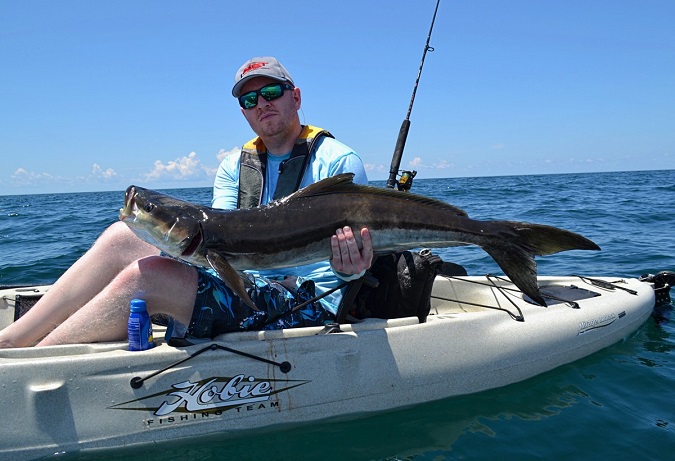Few fish demand more attention along the panhandle of Florida than cobia. Cobia winter over in south Florida and migrate up the Atlantic and Gulf coasts as the water temperature begins to rise in early spring.

The panhandle cobia migration takes place every spring, with the numbers of fish varying from year to year. The peak of this migration, the prime time for cobia, is generally agreed to be mid March through mid April. During those weeks, cobia of all sizes move up the coast, east-to-west along the white sand beaches of the Florida panhandle. The fish migrate northward from southern Gulf waters then turn west as they reach the panhandle shallows, moving toward the mouth of the Mississippi River. Early runs of most species in the northern Gulf waters generally produce smaller quantities of fish, but the biggest fish of the season are often caught during this time. This holds true with cobia. As the season progresses, quantities increase, but the average size will go down.
While most anglers focus on sight fishing during this initial peak time, cobia can be caught earlier in the year as well as throughout the summer months and into the fall. The early fish are typically caught near the water’s surface anywhere from just off the beach in the first trough to three miles offshore. By the end of May the cobia generally slow in their migration and will often hang around structure such as artificial reefs and wrecks in 50 to 100 feet of water. This is a great time to target them from your Hobie kayak!
A southeast wind and easterly current are ideal conditions for anglers sight fishing because it keeps the fish on the surface. The majority of cobia caught from a kayak are caught trolling live or frozen baits while targeting other species. Live bait is hard to beat and although most would agree that live eels are the best, they can be difficult to manage in a kayak. Keeping the eels in ice water will slow them down a bit and using a towel will help hold onto them while you get them on the hook. When using live eels, you will always want to have one rigged and ready to go at all times, due to how hard they are to get on the hook. Other great baits include cigar minnows, hardtails, pinfish, pigfish, ruby red lips, sardines and threadfin. I like having a variety of baits; having multiple offerings can be the key to success.
Cobia will often travel in pods and occasionally be found swimming with rays and large sharks. They will hang around anything floating and are very curious. A stealthy approach and accurate cast will usually result in a strike.
The more savvy kayak anglers will always have a brightly colored jig tied on ready to sight cast if a cobia is spotted or pops up. They will also focus their time and energy near structure as well as searching for anything floating.
I prefer spinning gear in the 30-pound class. A 7- to 8-foot medium-heavy to heavy fast action rod with a stout backbone is crucial to make quick accurate casts and drive the hook home. I spool a 5500 to 6500 series reel with 50-pound braided line and tie on a 2-foot 60-pound fluorocarbon leader using the FG knot. Some anglers prefer 20-30-pound monofilament main line with fluorocarbon leader connected with a swivel. If the fish have been heavily pressured or are finicky I will step down to a 40-pound leader. Depending on the bait I will either use a #1 or #2 4x Owner treble hook or a 7/0 to 9/0 Owner circle hook.
Cobia are powerful fish and fight very hard. It is important to take your time and play the fish out before attempting to bring it to the kayak. Once this is done you will need a stout gaff and bat to dispatch the fish in order to safely bring it onboard. Be aware that cobia almost always go into a death roll once gaffed and have very sharp points on their dorsal fin. I recommend having everything important stowed away and strapped down before attempting to boat the fish. Cobia must be 33 inches at the fork to legally harvest. If the fish’s length is questionable, a good pair of fish lip grips and an extra pair of hands are essential to getting an accurate measurement in the kayak.
The best way to catch cobia in your Hobie kayak is to keep it simple.
Cobia are excellent table fare and extremely fun to catch! Get out there and get one.
